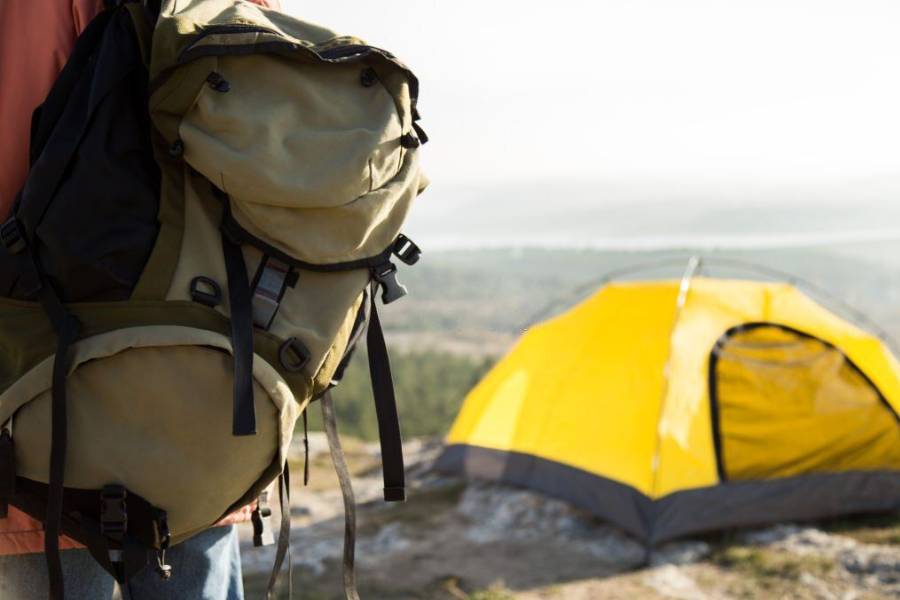
A tent is inevitably one of the bulkier and heavier items you’ll need to carry while camping or backpacking. Even ultralight tents can contribute a substantial amount of weight to your gear, and this becomes more noticeable the longer you’re on the trail.
That’s why mastering the skill of packing a tent in a backpack is essential, as it aids in reducing your overall load. Below, we’ll guide you through the process and provide tips on fitting a tent in a backpack, with a focus on utilizing a backpack with an internal frame.
Importance of Packing Your Tent Properly
Despite being a nice experience, going camping usually means you’ll be carrying a huge backpack for a long distance. This can be tiring. And having a poorly packed backpack will make your pack heavier, which in turn can make the whole hike pretty miserable. To avoid such situations, you will need to pack your backpack correctly, and this includes learning how to pack a tent in a backpack.

If you pack it properly before slipping it into your backpack, you can save a lot of space instead of just keeping it inside. Also, a poorly packed tent puts you at risk of being damaged by your other camping gear. Repairing a damaged tent fabric can be quite frustrating and requires time that could have been spent enjoying the outdoors.
Why Use a Backpack with an Internal Frame
When acquiring the skill of packing a tent in a backpack, it’s essential to begin by ensuring you have the right type of backpack for your outdoor adventure. In this case, you will need a backpack with an internal frame. This is different from an external frame backpack. Internal frame packs are designed to be much roomier and have a higher carrying capacity than an external frame pack. Having this extra space helps to ensure that there is enough room for your tent.
Make sure that your backpack is big enough for your tent. The bigger your tent, the bigger your backpack should be. To further reduce the amount of weight you’ll be carrying, consider investing in a lightweight backpack. Using a compression bag can also help keep the tent well-packed and snug.
Step-by-Step Guide: How to Pack a Tent in Your Backpack
Packing a camping tent inside a backpack isn’t rocket science. With that out of the way, now let’s take a look at the different steps on how to pack a tent in a backpack.
1. Prepare the Tent
First, make sure that the tent canvas and all other accessories are clean and completely dry. Wipe them clean if necessary. Now, take the tent poles, position them accordingly, and place them in the bag they came with when you bought your tent. Set them aside for a while. Then lay the tent tarp on the ground and flatten it down. Fold the tent canvas so that its size will fit in the backpack.
- Remember, your tent will be upright when you place it inside your backpack.
2. Roll the Tent
Place the bag of tent poles at one end of the folded tent canvas, then carefully roll the tent together with the poles tightly. Make sure the edges of the folded tent line up as you roll up the canvas. You’ll want the roll to be as tight as possible so it doesn’t take up too much space inside your backpacking pack. Also, if the tent is loosely rolled up, you will have a hard time putting it inside the tent bag.
3. Pack up the Tent
With the tent well rolled up, take the bag that came with the tent when you bought it and slide the rolled-up tent in. If you don’t have a dedicated bag, you can use a drawstring bag instead. The point is that you should put the rolled-up tent in a bag or sack so it doesn’t get caught on other items in your backpack. By now you will have a well-packed tent ready to carry in your backpack.
4. Pack Your Backpack
Take inventory of all the things that will go in your backpack, from your sleeping bag to your camping or hiking clothes and more. Place the sleeping bag in the bottom of your pack, as it will probably be the last item you need to take out once you arrive. It will also probably be the heaviest item you will carry and placing it at the bottom of the pack will help distribute the weight.
5. Put the Tent Inside the Backpack
Lastly, place the rolled-up tent on top of the sleeping bag. You will want to place it upright against one of the corners of the pack. You can then start filling the space with the rest of your camping gear. Be sure to pack everything nice and tight so there is no room for your roll-up tent to wobble as you walk.
Tips and Considerations
Practice packing methods at home at least a few days before your planned adventure. This will help develop your skills and make packing it up much easier for when it’s time to head home. This also allows you to see how much space you will have left when you pack the tent into your backpack and at the same time check to see if there are any issues.
If you’d rather learn how to pack a tent in a backpack and take it outside rather than put it inside, be aware that there are significant risks in doing so. It’s worth considering packing a tent on the outside of the bag, especially if you already have an external frame pack and don’t want to spend more money buying an internal frame pack.
Also, having a tent out of the bag will leave more room for your camping gear like backpacking stoves, water bottles, and others. Pick a waterproof backpack if possible, to make sure the tent inside and all the rest of your camping gear don’t get wet.
If you plan to carry your tent outside of your backpack, it can get wet if it rains or if you accidentally slip and fall into a stream, river, or pool of water. You can wrap the tent in plastic to minimize the amount of water that will enter the tent, or use a rain pack that goes all the way to the bottom of your backpack.
Frequently Asked Questions
How do you fit a tent into the bottom of a backpack?
To learn how to pack a tent into the bottom of a backpack, follow the steps below:
- Break Down the Tent: Disassemble your tent by removing stakes, poles, rainfly, and inner tent. Keep them organized to make setup easier later.
- Secure Poles and Stakes: Bundle tent poles together with the stake bag or use elastic bands. This prevents them from poking through your backpack or damaging other items.
- Pack the Bottom First: Place the folded tent and rainfly at the bottom of your backpack. This provides a stable base for the rest of your gear and ensures weight distribution.
- Use the Backpack’s Compartments: If your backpack has a separate compartment for the sleeping bag, use it. Otherwise, pack the sleeping bag on top of the tent for further weight distribution.
- Utilize Compression Straps: If your backpack has compression straps, tighten them to reduce the overall volume and keep the load secure. This helps in stabilizing the weight and prevents shifting during your hike.
- Adjust Straps for Comfort: Adjust shoulder straps, hip belts, and sternum straps to ensure a comfortable and balanced load. This helps prevent fatigue during your trek.
How to put your tent in your hiking backpack?
Under the hiking backpacks, there are normally straps to attach the tent. Otherwise, on the sides, there may be straps. In this case, you can balance the weight by putting the poles on one side and the canvas on the other.
Can I pack a wet tent?
It’s best to avoid packing a wet tent directly with the rest of your gear, as moisture can seep through. If your tent is wet, consider placing it in a separate waterproof bag or compartment to prevent other items from getting damp.
What should I do if my tent has air beams or inflatable poles?
Deflate the air beams or poles before packing to reduce their volume. Ensure they are tightly rolled or folded, and consider packing them in a dedicated compartment to prevent damage.
Conclusion
Going camping or backpacking usually means carrying a huge backpack on your back while walking long distances. By knowing how to pack a tent in a backpack, you can reduce stress both physical and mental. That accompanies the process. Whether you choose to pack your tent inside your backpack or externally by learning how to attach your tent to a backpack outside, your tent should be packed properly to prevent the early onset of fatigue and thus make your outdoor adventure that much more enjoyable.
Thanks for reading.
See you soon…